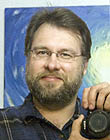|
|
This topic comprises 2 pages: 1 2
|
|
Author
|
Topic: Spiderman on the Big Screen? oh no!
|
Don E. Nelson
Expert Film Handler

Posts: 138
From: Brentwood, CA, USA
Registered: Nov 2001
|
 posted 05-06-2002 02:52 PM
posted 05-06-2002 02:52 PM




My kids wanted to see Spiderman on the "Big" screen, so I got on Fandango and got the 5:40pm "big screen" tickets for the local IMAX theater. The whole time iI was in line I was sipping my ($5.00) Coke and asking myself, is this a mistake? I know Spiderman will not be a 70mm print so what will the 35mm resolution be like, will it be in focus or fuzzy, will they use only a portion of the screen. etc. My kids just wanted a big image and a good story to be happy, I wanted something else, namely a well projected film.
The previews took some getting used to, the picture was so BIG, and a little fuzzy/hazzy on some of the teasers, but when the feature came on, I was pleasantly surprized how good it looked. It good have been sharper for my taste but it was OK. My question is, not all films will look good projected this way, what is the limiting factor for projection on an IMAX screen: the film stock, lighting, film format, camera type, optics, projector, etc.
Thanks------------------
...more signal, less noise!
| IP: Logged
|
|
John Pytlak
Film God

Posts: 9987
From: Rochester, NY 14650-1922
Registered: Jan 2000
|
 posted 05-06-2002 03:12 PM
posted 05-06-2002 03:12 PM





With "Film Done Right", a 35mm camera negative can produce very acceptable images on very large screens. Since the mid-1960's, 35mm blow-ups to 70mm prints were used for the "Star Wars" trilogy, the "Indiana Jones" trilogy, and a host of other very successful pictures (e.g., "Titanic"). Ron Howard's "Apollo 13", shot on 35mm film, is being digitally reformatted ("Digital Intermediate") to 15-perf 70mm IMAX, showing the flexibility and "future proof" ability of film origination:
http://www.collectspace.com/news/news-032102a.html One of the major challenges in filling a huge screen is getting enough light. A larger 70mm format allows "spreading out" the energy of the lamp, reducing heat-related problems. But even 35mm prints with "Film Done Right" can fill some pretty big screens. I recently went to a 35mm screening at a local IMAX theatre that was quite acceptable for sharpness and screen luminance. They were using a 6K Christie lamp (160 amperes), projecting onto the IMAX 3D (high gain) screen, with about a 70-foot wide scope image. I know that Gordon McLeod takes pride in the quality of the 35mm images he is able to project at the Toronto Ontario Place IMAX theatre. You certainly won't be able to achieve 16 footlamberts on an 84-foot screen using a 35mm print --- that needs 70mm. But very acceptable results are achievable, and attracting audiences to these 35mm screenings on huge screens.
------------------
John P. Pytlak, Senior Technical Specialist
Worldwide Technical Services, Entertainment Imaging
Research Labs, Building 69, Room 7525A
Rochester, New York, 14650-1922 USA
Tel: +1 585 477 5325 Cell: +1 585 781 4036 Fax: +1 585 722 7243
e-mail: john.pytlak@kodak.com
Web site: http://www.kodak.com/go/motion
| IP: Logged
|
|
|
|
|
|
|
|
John Pytlak
Film God

Posts: 9987
From: Rochester, NY 14650-1922
Registered: Jan 2000
|
 posted 05-06-2002 03:30 PM
posted 05-06-2002 03:30 PM





Joe asked: "What would you say would be the biggest screen possible to achieve 16 footlamberts on with 35mm? 70mm? "Lots depends upon the efficiency and alignment of the projector (lamphouse, shutter, lens, port glass), and the type of screen used. For 35mm prints, the Strong/Isco-Optic slide rule calculator shows that a 7K lamphouse should be able to light a 24 x 58 foot matte white (gain = 1) screen. Going to a properly curved 1.5 gain screen allows up to a 27 x 65 foot image. I recall that the North Park in Dallas had plenty of light with 70mm and a much smaller lamp when they showed "Titanic". Brad can give the details. With 70mm having about three times the image area of 35mm scope, you can put much more light on the screen. ------------------
John P. Pytlak, Senior Technical Specialist
Worldwide Technical Services, Entertainment Imaging
Research Labs, Building 69, Room 7525A
Rochester, New York, 14650-1922 USA
Tel: +1 585 477 5325 Cell: +1 585 781 4036 Fax: +1 585 722 7243
e-mail: john.pytlak@kodak.com
Web site: http://www.kodak.com/go/motion
| IP: Logged
|
|
John Pytlak
Film God

Posts: 9987
From: Rochester, NY 14650-1922
Registered: Jan 2000
|
 posted 05-06-2002 03:38 PM
posted 05-06-2002 03:38 PM





Adam said: "The prints were printed lighter to give the appearance of more light on the screen, but reducing the contrast."Usually a print "color timed" to look best at the 16 footlambert aim specified by SMPTE 196M will be the best choice for theatres that have lower light levels. Making the print less dense will change the tone scale, resulting in smoky shadows, pasty fleshtones, desaturated colors, and highlights without detail. Taken to an extreme example, if you have a really dim projector, why not make the print so light that it is clear film without an image?  ------------------
John P. Pytlak, Senior Technical Specialist
Worldwide Technical Services, Entertainment Imaging
Research Labs, Building 69, Room 7525A
Rochester, New York, 14650-1922 USA
Tel: +1 585 477 5325 Cell: +1 585 781 4036 Fax: +1 585 722 7243
e-mail: john.pytlak@kodak.com
Web site: http://www.kodak.com/go/motion
| IP: Logged
|
|
Brad Miller
Administrator

Posts: 17775
From: Plano, TX (36.2 miles NW of Rockwall)
Registered: May 99
|
 posted 05-06-2002 03:38 PM
posted 05-06-2002 03:38 PM




At GCC Northpark 1&2 we were using Cinemecannica horizontal "Zenith" lamphouses with IREM power supplies. Those lamphouses were nothing short of magnificent. The screen was a matte Hurley. We used OSRAM lamps for years, but after pressuring Ron, he agreed to try a Christie bulb and we got even better light. This was only a couple of months before Titanic opened.Oh yes and for Mr.Guttag I might add that according to Paramount we were the only theater to run that film in 70mm that did not scratch it, replace at least one reel or have any damage whatsoever to it...and we did it on a platter!  The theaters that ran it changeover damaged their prints to one degree or another. The theaters that ran it changeover damaged their prints to one degree or another. For more useless history about Northpark, that print of Titanic in 70mm was also the only print ever to be interlocked there. Rather than break it down only to build it right back up or try to move it (which would have been basically impossible) I interlocked it from cinema 1 to cinema 2 after hours for the final week of it's run.
| IP: Logged
|
|
|
|
|
|
|
|
|
|
|
|
Bobby Henderson
"Ask me about Trajan."

Posts: 10973
From: Lawton, OK, USA
Registered: Apr 2001
|
 posted 05-07-2002 05:25 PM
posted 05-07-2002 05:25 PM




I still have my ticket stub from seeing "Titanic" in DTS 70mm at Northpark #1 (as well as stubs from a number of other shows there). That house was easily my favorite place to watch films. I found out about the place only by accident when passing through Dallas during my move from Georgia to Oklahoma in 1993. I wanted to see "Jurassic Park" in THX-DTS, and Northpark 1-2 wasn't far out of the way. I was impressed when entering the #1 theater, finding it to be every bit as cavernous as the big premiere houses in New York City. The sound quality was the best I have ever heard in a commercial movie theater. It really sucks out loud that this theater (Texas' Best) is gone. To get back on topic, most know how I feel about blowing 35mm prints up on giant screens (hate it). The image quality might be "acceptable", but it sure doesn't touch what 70mm can do.
| IP: Logged
|
|
|
|
|
|
All times are Central (GMT -6:00)
|
This topic comprises 2 pages: 1 2
|
Powered by Infopop Corporation
UBB.classicTM
6.3.1.2
The Film-Tech Forums are designed for various members related to the cinema industry to express their opinions, viewpoints and testimonials on various products, services and events based upon speculation, personal knowledge and factual information through use, therefore all views represented here allow no liability upon the publishers of this web site and the owners of said views assume no liability for any ill will resulting from these postings. The posts made here are for educational as well as entertainment purposes and as such anyone viewing this portion of the website must accept these views as statements of the author of that opinion
and agrees to release the authors from any and all liability.
|

 Home
Home
 Products
Products
 Store
Store
 Forum
Forum
 Warehouse
Warehouse
 Contact Us
Contact Us




 Printer-friendly view of this topic
Printer-friendly view of this topic













 The theaters that ran it changeover damaged their prints to one degree or another.
The theaters that ran it changeover damaged their prints to one degree or another. 







